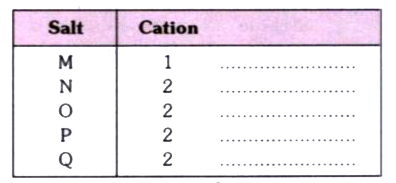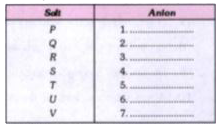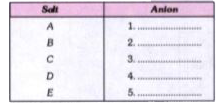Salts M, N, O, P and Q undergo reactiom (i) to (v) respectively.
Identify the cation present in these salts on the basis of these reaction. Tabulate your answer in the format given below.
1. When sodium hydroxide solution is added to the salt M, and heated strongly a colourless gas with a pungent smell is evolved which turm red litmus paper blue and gives dense white fumes with a moist glass rod with hydrochloric acid.
2. Addition of dilute hydrochloric acid to a solution of N gives a thick white precipitate which is soluble in hot water.
3. When ammonium hydroxide solution is added to the solution of 0 a light blue precipitate is obtained which is soluble in excess of ammonium hydroxide to form an inteme deep blue solution.
4. When ammonium hydroxide solution is added to the solution of P reddish brown (mustard colour) precipitate is obtained which ,is insoluble even in the excess of ammonium hydroxide solution.
5. When sodium hydroxide solution is added to the solution of Q a which coloured gelatinous precipitate is obtained which is soluble in excess of sodium hydroxide to form a clear solution

Step by step video & image solution for Salts M, N, O, P and Q undergo reactiom (i) to (v) respectively. Identify the cation present in these salts on the basis of these reaction. Tabulate your answer in the format given below. 1. When sodium hydroxide solution is added to the salt M, and heated strongly a colourless gas with a pungent smell is evolved which turm red litmus paper blue and gives dense white fumes with a moist glass rod with hydrochloric acid. 2. Addition of dilute hydrochloric acid to a solution of N gives a thick white precipitate which is soluble in hot water. 3. When ammonium hydroxide solution is added to the solution of 0 a light blue precipitate is obtained which is soluble in excess of ammonium hydroxide to form an inteme deep blue solution. 4. When ammonium hydroxide solution is added to the solution of P reddish brown (mustard colour) precipitate is obtained which ,is insoluble even in the excess of ammonium hydroxide solution. 5. When sodium hydroxide solution is added to the solution of Q a which coloured gelatinous precipitate is obtained which is soluble in excess of sodium hydroxide to form a clear solution by Chemistry experts to help you in doubts & scoring excellent marks in Class 10 exams.
Topper's Solved these Questions
- BOOK - ICSECHAPTER - ANALYTICAL CHEMISTRY- USE OF AMMONIUM HYDROXIDE AND SODIUM HYDROXIDEEXERCISE - Questions from Previous ICSE Board Papers45videos
ANALYTICAL CHEMISTRY- USE OF AMMONIUM HYDROXIDE AND SODIUM HYDROXIDE
- BOOK - ICSECHAPTER - ANALYTICAL CHEMISTRY- USE OF AMMONIUM HYDROXIDE AND SODIUM HYDROXIDEEXERCISE - Questions from Previous ICSE Board Papers45videos
ANALYTICAL CHEMISTRY- USE OF AMMONIUM HYDROXIDE AND SODIUM HYDROXIDE
- BOOK - ICSECHAPTER - ANALYTICAL CHEMISTRYEXERCISE - Figure Based Questions2videos
ANALYTICAL CHEMISTRY
- BOOK - ICSECHAPTER - ANALYTICAL CHEMISTRY-USE OF AMMONIUM & SODIUM HYDROXIDEEXERCISE - Additional Questions6videos
ANALYTICAL CHEMISTRY-USE OF AMMONIUM & SODIUM HYDROXIDE
Similar Questions
Salts P, Q,R,S,T,U and V undergo reactions (i) to (vii) respectively. Identify the cation present in these salts on the basis of these reactions. Tabulate your answer in the formate given below.
(i) When the salt Pis heated with sodium hydroxide solution a vigorous reaction takes place and a colourless gas is evolved with a pungent and suffocating smell that brings tears in our eyes. The evolved gas gives dense white fumes with a moist glass rod depped with hydrochloric acid.
(ii) Addition of sodium hydroxide solution to a solution of salt Q gives a thick white precipitae which is soluble in excess of sodium hydroxide solution to form a clear solution.
(iii) Addition of ammonium hydroxide solution to a solution of salt R gives a dark blue precipitate which is soluble is excess of ammonium hydroxide solution to form an intense deep blue solution.
(iv) Addition of ammonium hydroxide solution to a solution of 5 gives a dirty green [bottle green] precipitate which is insoluble even in the excess of ammonium hydroxide solution.
(v) Addition of ammonium hydroxide solution to a solution of T gives a reddish brown (rust precipitate] precipitate which is insoluble even in the excess of ammonium hydroxide solution.
(vi) Addition of ammonium hydroxide solution to a solution of V gives a geletaneous white precipitate which is soluble in excess of ammonium hydroxide solution to form a clear solution.
(vii) Addition of ammonium hydroxide solution to a solution of V gives no precipitate but it gives a chalky white precipitate with sodium hydroxide solution which is insoluble even in the excess of sodium hydroxide solution.
 View Solution
View SolutionIdentify the cation in each of the following case
Ammonium hydroxide solution when added to the solution B gives white precipitate which dissolves in excessView Solution
Knowledge Check
- Question 1 - Select One
Which one of the following salt solutions on reaction with excess of ammonium hydroxide solution gives a deep blue solution ?
AFeCl3(aq)BCuSO4(aq)CAl2(SO4)3(aq)DZnSO4(aq)
Identify the cation in each of the following case
Sodium hydroxide solution when added to solution C gives bluish white precipitate which is insoluble in excess.View SolutionIdentify the cation in each of the following case
Sodium hydroxide solution when added to the solution 'A' gives reddish brown precipitate.View SolutionIdentify the cation in each of the following case
Ammonium hydroxide solution when added to the solution gives bluish white precipitate which dissolves in excess to give deep blue solution.View SolutionSalts K, L, M, N and O undergo reaction (i) to (v) respectively with different reagents given below. Identify the cation present in these salts on the basis of these reaction. Tabulate your answer in the format given below:
(i) Addition of potassium chromate solution to a solution of salt K gives a golden yellow precipitate.
(ii) Addition of potassium ferrocyanide solution to a solution of slat L gives a chocolate brown precipitate.
(iii) Addition of potassium ferricyanide solution to a solution of salt M gives an intese deep blue solution.
(iv) Addition of potassium ferrocyanide solution to a solution of O gives a bluish white precipitate.
 View Solution
View SolutionA white sodium salt dissolves in water to give a solution which is neutral to litmus.When silver nitrate solution is added to the solution, a white precipitate is obtained which does not dissolve in dilute HNO3.The anion is
View SolutionSalts A, B, C, D and E undergo reactions (i) to (v) respectively. Identify the anion present in these salts on the basis of these reactions. Tabulate your answers in the format given below:
(i) When silver nitrate solution is added to a solution of A, a white precipitate, insoluble in dilute nitric acid, is formed.
(ii) Addition of dilute hydrochloric acid to B produces a gas which turns lead acetate paper black.
(iii) When a freshly prepared solution of ferrous sulphate is added to a solution of C and concentrated sulphuric acid is gently poured from the side of the test-tube, a brown ring is formed.
(iv) When dilute sulphuric acid is added to D a gas is produced which turns acidified potassium dichromate solution from orange to green.
(v) Addition of dilute hydrochloric acid to E produces an effervescence. The gas produced turns lime water milky but does not affect acidified potassium dichromate solution.
 View Solution
View SolutionThe salt which in solution gives a pale green precipitate with sodium hydroxide solution and a white precipitate with barium chloride solution is
View Solution

